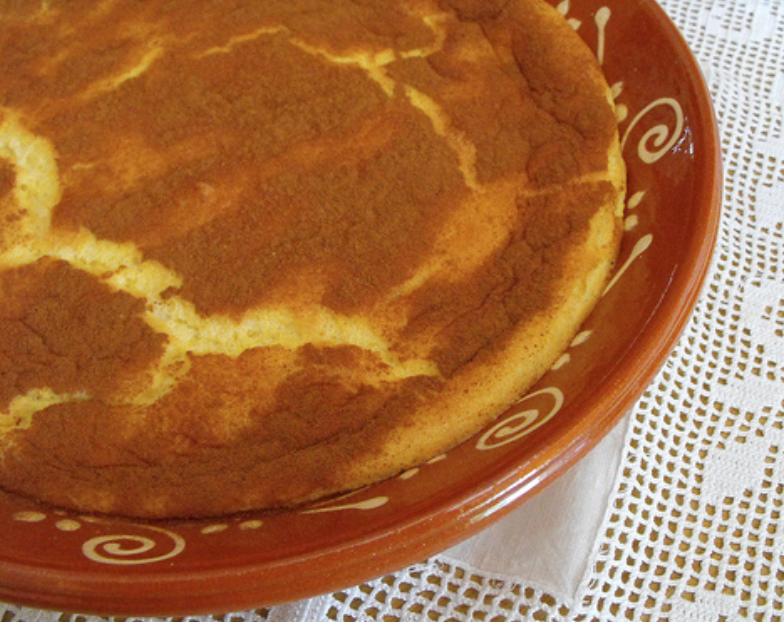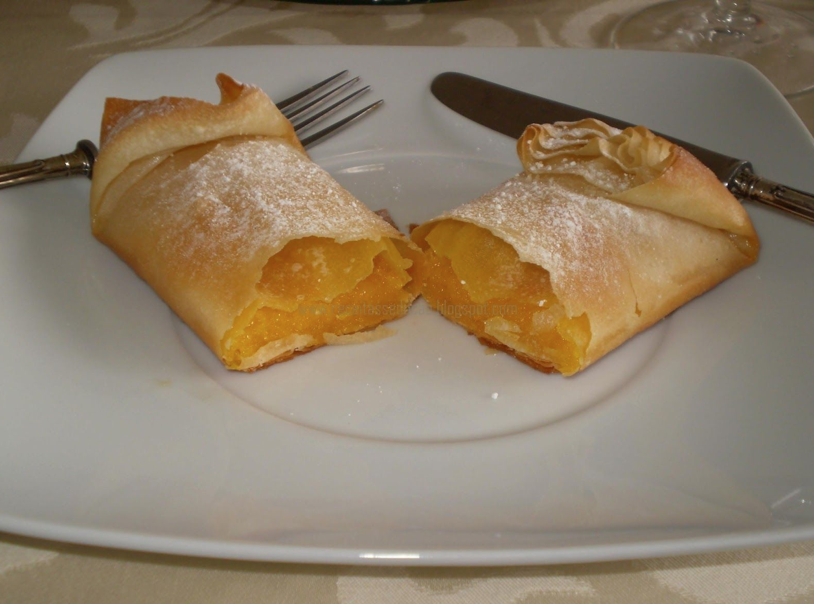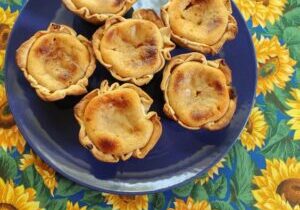15 famous traditional portuguese desserts you need to taste
![]()
There are a lot of portuguese desserts, but what are their origins ? Convents ! When sugar arrived in the convents in Portugal, Portuguese nuns and monks created many recipes based on it. But not only that ! They also used eggs in their recipes, especially egg yolks. Why egg yolks ? Do you have any idea ?
The nuns in the convents used egg whites to iron their clothes, it prevented the iron from sticking and it made the fabrics stiffer and shiny. In order not to waste the remaining egg yolks, the nuns and monks had the idea of using them in their recipes. Added to the sugar they had in abundance, this gave rise to many Portuguese desserts, which are still very present in Portuguese gastronomy today.
These desserts are called “doces conventuais”, which means the desserts of the convents. This is why many portuguese desserts come from local convents. Discover these desserts.

Pão de ló
The “pão de ló” is a traditional Portuguese cake. A simple dessert : eggs, sugar and flour! Depending on the region where you find it, the centre of the cake is more or less moist. It can be dry to liquid. The dry ones are usually easily recognizable because the cake has a hole in the middle.
The best known “pão de ló” (“wet” version) are those from the cities of Ovar and Alfeizerão. The story goes that they are liquid inside due to the mistake of a cook. When she made the recipe for the visit of a king, in a hurry, she took the cake out of the oven before the time needed for baking. The heart of the cake was still almost liquid but the king loved it and the recipe remained.
Also, note that this dessert was introduced to Japan when the first Portuguese people reached the country and today the “pão de ló” is also a very popular dessert in Japan where it is called “pan”.
Pão de ló
2. Toucinho do céu
Some of the “doces conventuais” (convent desserts) have names with religious connotations. This is the case of this dessert : “Toucinho do céu” which means “fat from heaven”.
This portuguese dessert is made with almonds and …. pork fat. Curious, isn’t it ?!? It was created by the nuns of the convent of Santa Clara de Guimarães, in the north of the country. It is a very popular Portuguese dessert. The name doesn’t necessarily attract, but it’s delicious!
Toucinho do céu
3. Sericaia
It is a dessert from Alentejo (beautiful region under Lisbon). It is one of the unavoidable “doces conventuais” (convent desserts) with the marked presence of eggs and cinnamon. One of the rules to follow to make this Portuguese dessert is that cracks must form during cooking. If you go to Alentejo, you can’t miss this portuguese dessert, it can be found everywhere!
Sericaia
4. Pastel of Tentúgal
The “Pastel of Tentúgal” is a tasty and crunchy. This dessert is filled with eggs yolks, so you won’t be surprised if I tell you that it was born in the convent da Nossa senhora da natividade in Tentúgal in the 16th century. This dessert is “protected” by the Indicação Geográfica Protegida (IGP), which is why it can only be produced in the Coimbra region. It is the speciality of the small towns of Tentúgal and Montemor-o-Velho.
Pastel of tentúgal
5. Ovos moles
This Portuguese dessert is typical of the Aveiro region (south of Porto). It was created in the convent of Jesus da Ordem Dominicana feminina, which is now the museum of Aveiro.
The “ovos moles” consist of a pastry with egg yolks and sugar wrapped in a kind of host. The shape of these small sweet treats is very often inspired by the marine world with a shell or fish shape.
Like the “Pastel de Tentúgal”, the “ovos moles” are “protected” and can only be produced in the region of Aveiro. It is the first portuguese dessert to have had its recipe protected. The “ovos moles” from Aveiro generate 5 million euros per year!
Ovos moles
6. Pastel of Belém
The very famous pastel of Belém is like many other portuguese desserts : a doce conventual ! It is a kind of small puff pastry tart topped with an egg and sugar cream on which you can add cinnamon.
This portuguese dessert was created by the monks of Belém (a district of Lisbon) in a shop next to the dos Jerónimos monastery. The shop still exists and it is very popular. The “real recipe » of the “pastel of Belém”, has always remained a secret and explains why the quality of these pasteis is so renowned.
Pastel de Belém
7. Cornucopia
Cornucopia symbolized fertility and abundance. The shape of the ice cream cone makes it easy to identify this portuguese dessert made from flour, butter, sugar, lard, toast, slivered almonds and egg yolks (yes, it is a “doce conventual”).
Like some other “doce conventuais” the exact origin of this pastry is disputed by several regions. Some say that the “cornucopia” comes from the Monastery of Cós in the region of Alcobaça. Others say that this sweet comes from the Azores and more specifically from “Angra do Heroísmo”, a town on the island of Terceira. It doesn’t matter what you tell me, the important thing is that it is delicious to taste !
Cornucopia
8. Cavacas
Sabrosa, Aveiro, Coimbra, Santa Clara, Resende, Caldas da Rainha, Amarante… “Cavacas” are portuguese biscuits that can be found almost everywhere in Portugal. Depending on the region, the shape (round, oval, elongated) and texture (soft, hard) vary slightly. The most common shape is oval like the one I am tasting on the main picture of this article.
In Aveiro, during the São Gonçalinho festival in January, “cavacas” are thrown from the top of the city’s chapels and people in the street have to catch them with the help of overturned umbrellas. It’s very nice to be part of it!
São Gonçalinho celebration
9. Pastel of Santa Clara
This portuguese dessert, which can have different shapes: half moon, star… was invented in a convent in Coimbra. Due to the economic difficulties of the religious orders in the 19th century, the nuns sold this dessert to the students of the famous and very popular University of Coimbra.
Pastel of Santa Clara
10. Torta de laranja
This dessert with a subtle orange flavour is a kind of moist cake rolled with orange juice, butter, eggs and sugar.
It is a 16th century dessert, its origin is not 100% certain but many people agree that this Portuguese dessert is said to come from the convent of Nossa Senhora da Conceição de Lagos (in the Algarve). Others say it comes from the Convent of Jesus in Setubal (south of Lisbon). One region or the other would not be surprising since both regions are famous for having quality oranges.
Torta de laranja
11. Barriga de freira
This dessert has an “original” name since “Barriga de freira” means “belly of the nun” and it looks a little bit like a belly. It is a traditional portuguese dessert that was created in the 15th century in convents (“doce conventual”). Depending on the region, there are several variations to this dessert but the common base is the egg. The one in the picture below has a crunchy cover made with almonds.
Barriga de freira
12. Bolo de bolacha
The bolo de bolacha is one of the most famous portuguese dessert. As with many Portuguese desserts (seradura, natas do céu, salame,…), this dessert includes the “bolacha Maria” biscuit.
This dessert looks a little bit like tiramisu. In fact, it is prepared with the “bolacha Maria” biscuits which are dipped in coffee and on top of which you put butter cream. Then we start again, a layer of biscuits soaked in coffee and a layer of butter cream and so on until … Don’t think too much about the calories, just enjoy the moment!
Bolo de bolacha
13. Natas do céu
“Natas do céu” which means “Cream of Heaven” is the dessert you find in every restaurant in Portugal and this is not surprising since it is one of the favorite desserts of the Portuguese.
It is a dessert that you can easily recognize in the restaurants since it is usually in a glass and you can easily identify the different layers of this dessert. The first one is a kind of crumble made with “bolacha Maria” biscuits, then there is a layer of egg white and sugar. And finally, the last layer is a kind of egg cream.
Natas do céu
14. Aletria
It is a portuguese dessert that you can easily find on Christmas tables. This dessert looks like “arroz doce” (Portuguese rice pudding) but instead of rice it is noodles.
Aletria has Arabic origins where the pasta was cooked in almond milk and honey. In fact, the name “Aletria” comes from the Arabic “al-irtiâ” which means pasta. Aletria arrived on the Iberian Peninsula : “Andalusia” and “Algarve”, via the Moors at the end of the 8th century.
Depending on the region, there are different recipes for Aletria, with more or less pasta, with or without egg yolk, with a more or less creamy consistency …
Aletria
15. Salame
I wanted to tell you about this dessert because it is finally one of the “rare” Portuguese desserts with chocolate. Salame is a traditional portuguese dessert but not only ! It is also the traditional dessert of another country … Do you know which one ? Italy !
This little sweet is made of chocolate, the famous “bolacha Maria” biscuits, butter, sugar and eggs. It is called “salame” because it has the false air of “salami”, the Italian salami.
Salame
Conclusion
Even if the “salty” portuguese gastronomy are more famous that the “sweet” one, you saw in this article that it exists a lot of pastries to taste in Portugal ! What is your favourite portuguese dessert?
Receive each month our latest blog articles and updated selection of properties.
* indicates requiredFirst Name *Last Name Phone Number Email Address *Current location Centre of interest *
- Buying a property in Portugal
- Renting a property in Portugal
- Nothing special at the moment
Arrival date in Portugal How could we assist you? * Contact me please: *
- As soon as possible
- Later
Area of interest in Portugal *
- North
- Lisbon
- South of Lisbon
- Algarve
- Other
[tcb-script type=”text/javascript” src=”//s3.amazonaws.com/downloads.mailchimp.com/js/mc-validate.js”][/tcb-script][tcb-script type=”text/javascript”](function($) {window.fnames = new Array(); window.ftypes = new Array();fnames[1]=’FNAME’;ftypes[1]=’text’;fnames[2]=’LNAME’;ftypes[2]=’text’;fnames[3]=’PHONE’;ftypes[3]=’phone’;fnames[0]=’EMAIL’;ftypes[0]=’email’;fnames[8]=’CITY’;ftypes[8]=’text’;fnames[4]=’INTEREST’;ftypes[4]=’radio’;fnames[5]=’ARRIVAL’;ftypes[5]=’text’;fnames[6]=’HELP’;ftypes[6]=’text’;fnames[9]=’CONTACT’;ftypes[9]=’radio’;fnames[7]=’SOURCE’;ftypes[7]=’text’;fnames[10]=’AREA’;ftypes[10]=’radio’;}(jQuery));var $mcj = jQuery.noConflict(true);[/tcb-script]
Confidentiality: please ensure you have read and understood our Terms of Use & our Privacy Policy
Articles Populaires
dernières annonces

2 bedroom apartment with sea view, 10km from Lisbon and 2km from the beaches
Rua da Bica, 103Discover this magnificent 2 bedroom apartment with views of Arriba Fóssil and the sea, 2km…

Duplex apartment with sea view 15 minutes from Lisbon
rua Santa Teresa 7Bedroom + duplex apartment with sea view and 15 minutes from Lisbon.

Single-storey house with swimming pool
Just a few meters from the magnificent bay of São Martinho do Porto, lies this…

Condominium apartments facing the sea
São Martinho do PortoBeautiful apartments in São Martinho do Porto “Janela da Baía”! Located in the heart of…

Villa already finished and ready to move in: 4-suite bungalow on 750m2 plot in a quiet area of Azeitão
Rua de ParisHouse already finished and ready to move into! Close to shops and services, quick access…

Magnificent house with basement, indoor and outdoor pool in Verdizela/Aroeira
Verdizela/AroeiraNew turnkey project: magnificent single-storey villa, 498m2 in surface area, high-end finishes on a 1875m2…

Luxury apartment on the edge of a nature reserve
Your modern, spacious apartment between the beach and Lisbon’s capital. – Beach 5min – Golf…

House T3 1 10 min from Lisbon and 5 min from the beaches
PêraREADY TO MOVE IN! New T3 1 ready-to-live-in house in a quiet, rural neighborhood with…

4 bedroom villa with pool and jacuzzi in Aroeira
rua são miguelModern, minimalist architect-designed house with exceptional details in a quiet location in Aroeira 2-storey house…
Inscrivez-vous à notre newsletter
Recevez chaque mois les derniers articles de notre blog "la vie au Portugal" et notre sélection de biens immobiliers à vendre.



























